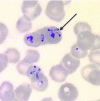Diseases from North America: focus on tick-borne infections
- PMID: 25650204
- PMCID: PMC4954531
- DOI: 10.7861/clinmedicine.14-6-74
Diseases from North America: focus on tick-borne infections
Abstract
Tick-borne infections are seen throughout the United States, with varying geographical locations. Many of these infections are also increasingly seen in Europe. Certain ticks (eg Ixodes) can transmit more than one infection. Diagnosis, particularly in early infection, can be challenging and therefore knowledge of the distinguishing clinical features and epidemiology of these diseases is important. Testing for Lyme disease often causes confusion for patients and medical providers, as serological tests may be negative in early infection and conversely may be positive for years after infection. Newer tests, such as the C6 ELISA, may play a role in Lyme diagnosis. Additionally, the value of a simple blood film should not be underestimated for diagnosing babesiosis and anaplasmosis. In certain situations, empiric therapy may be required for tick-borne infections as severe illness with multiorgan failure can occur, particularly in older and immunocompromised hosts. This review describes the more commonly seen tick-borne infections: Lyme, babesiosis, anaplasmosis and Rocky Mountain Spotted Fever. More recently identified tick-borne infections, such as southern tick-associated rash illness and Borrelia miyamotoi, are also covered.
Keywords: Anaplasma; Babesia; Lyme; Rocky Mountain spotted fever; tick-borne.
© 2015 Royal College of Physicians.
Figures




Similar articles
-
Are other tick-borne infections overlooked in patients investigated for Lyme neuroborreliosis? A large retrospective study from South-eastern Sweden.Ticks Tick Borne Dis. 2021 Sep;12(5):101759. doi: 10.1016/j.ttbdis.2021.101759. Epub 2021 Jun 4. Ticks Tick Borne Dis. 2021. PMID: 34161869
-
Molecular Detection of Tick-Borne Pathogens in Humans with Tick Bites and Erythema Migrans, in the Netherlands.PLoS Negl Trop Dis. 2016 Oct 5;10(10):e0005042. doi: 10.1371/journal.pntd.0005042. eCollection 2016 Oct. PLoS Negl Trop Dis. 2016. PMID: 27706159 Free PMC article.
-
Committee Opinion No. 399: Management of Tick Bites and Lyme Disease During Pregnancy.J Obstet Gynaecol Can. 2020 May;42(5):644-653. doi: 10.1016/j.jogc.2020.01.001. J Obstet Gynaecol Can. 2020. PMID: 32414479
-
Borrelia miyamotoi infection in nature and in humans.Clin Microbiol Infect. 2015 Jul;21(7):631-9. doi: 10.1016/j.cmi.2015.02.006. Epub 2015 Feb 18. Clin Microbiol Infect. 2015. PMID: 25700888 Free PMC article. Review.
-
The eye and tick-borne disease in the United States.Curr Opin Ophthalmol. 2016 Nov;27(6):530-537. doi: 10.1097/ICU.0000000000000308. Curr Opin Ophthalmol. 2016. PMID: 27585218 Review.
Cited by
-
Integrative analysis highlights molecular and immune responses of tick Amblyomma americanum to Escherichia coli challenge.Front Cell Infect Microbiol. 2023 Jul 31;13:1236785. doi: 10.3389/fcimb.2023.1236785. eCollection 2023. Front Cell Infect Microbiol. 2023. PMID: 37583446 Free PMC article.
-
Spatio-temporal modelling of tick life-stage count data with spatially varying coefficients.Geospat Health. 2021 Oct 20;16(2):10.4081/gh.2021.1004. doi: 10.4081/gh.2021.1004. Geospat Health. 2021. PMID: 34672184 Free PMC article.
-
Human Babesiosis: Pathogens, Prevalence, Diagnosis and Treatment.Curr Clin Microbiol Rep. 2015 Dec;2(4):173-181. doi: 10.1007/s40588-015-0025-z. Epub 2015 Sep 28. Curr Clin Microbiol Rep. 2015. PMID: 26594611 Free PMC article.
-
Unveiling Lyme Neuroborreliosis in the Absence of Dermatological Symptoms.Cureus. 2024 Dec 27;16(12):e76473. doi: 10.7759/cureus.76473. eCollection 2024 Dec. Cureus. 2024. PMID: 39867056 Free PMC article.
References
-
- Wormser GP, Dattwyler RJ, Shapiro ED, et al. The clinical assessment, treatment, and prevention of lyme disease, human granulocytic anaplasmosis, and babesiosis: clinical practice guidelines by the Infectious Diseases Society of America. Clin Infect Dis 2006;43:1089–134.10.1086/508667 - DOI - PubMed
Publication types
MeSH terms
Substances
LinkOut - more resources
Full Text Sources
Other Literature Sources
Medical

